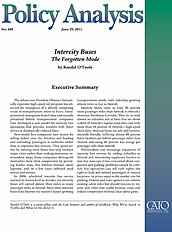The debate over President Obama’s fantastically expensive high-speed rail program has obscured the resurgence of a directly competing mode of transportation: intercity buses. Entrepreneurial immigrants from China and recently privatized British transportation companies have developed a new model for intercity bus operations that provides travelers with faster service at dramatically reduced fares.
New-model bus companies save money by selling tickets over the Internet and loading and unloading passengers at curbsides rather than in expensive bus stations. They speed service by running most buses non-stop between major cities rather than making numerous intermediate stops. Some companies distinguish themselves from their competition by providing leather seats, free wireless Internet, more legroom, and — in a few cases — onboard meal service and movies.
In 2006, scheduled intercity bus service reached its lowest level in decades, yet intercity buses still carried almost three times as many passenger miles as Amtrak. Since then, intercity buses have become the nation’s fastest-growing transportation mode, with ridership growing almost twice as fast as Amtrak.
Intercity buses carry at least 50 percent more passenger miles than Amtrak in Amtrak’s showcase Northeast Corridor. They do so with almost no subsidies and at fares that are about a third of Amtrak’s regular train fares and little more than 10 percent of Amtrak’s high-speed Acela fares. Intercity buses are safe and environmentally friendly, suffering almost 80 percent fewer fatalities per billion passenger miles than Amtrak and using 60 percent less energy per passenger mile than Amtrak.
Policymakers can encourage expansion of intercity bus services by ending subsidies to Amtrak and minimizing regulatory barriers to new bus start-ups. Cities concerned about congestion and parking problems caused by curbside bus operations can sell curb rights — the right to load and unload passengers at various locations — at prices equal to the market rate for parking. Federal and state agencies can enforce existing safety rules but should hesitate to impose new rules that could increase costs and reduce competition without clear safety gains.

This work is licensed under a Creative Commons Attribution-NonCommercial-ShareAlike 4.0 International License.

